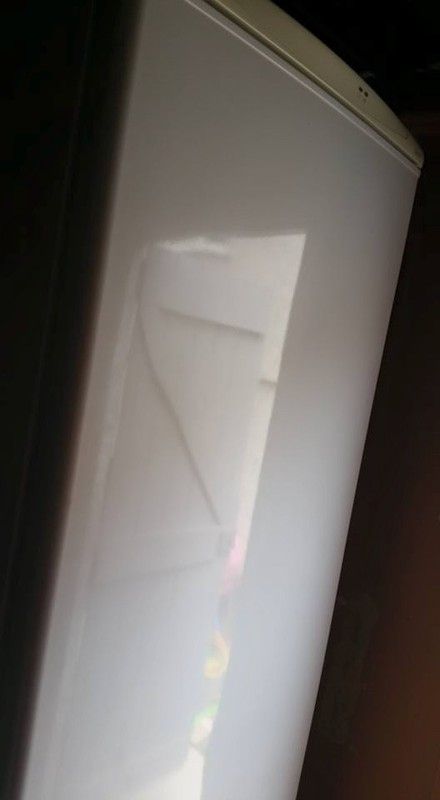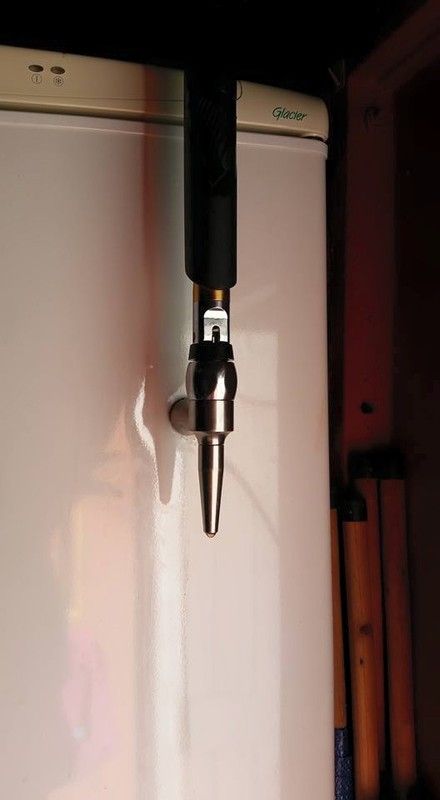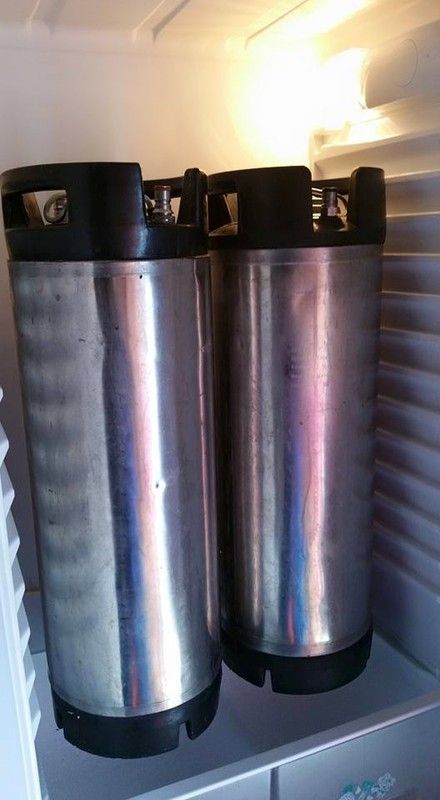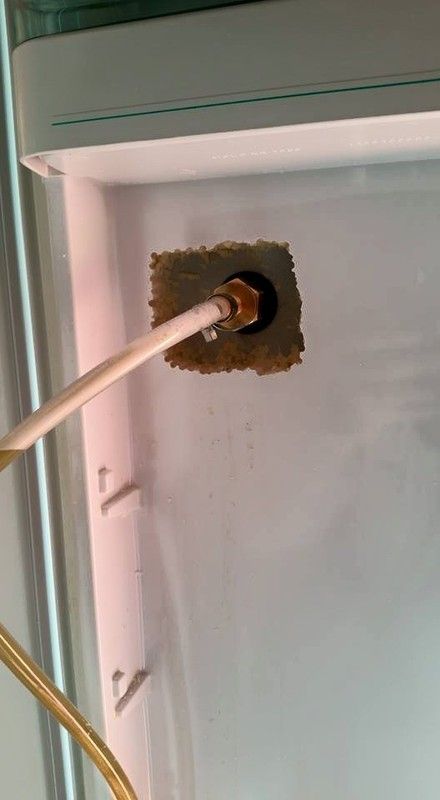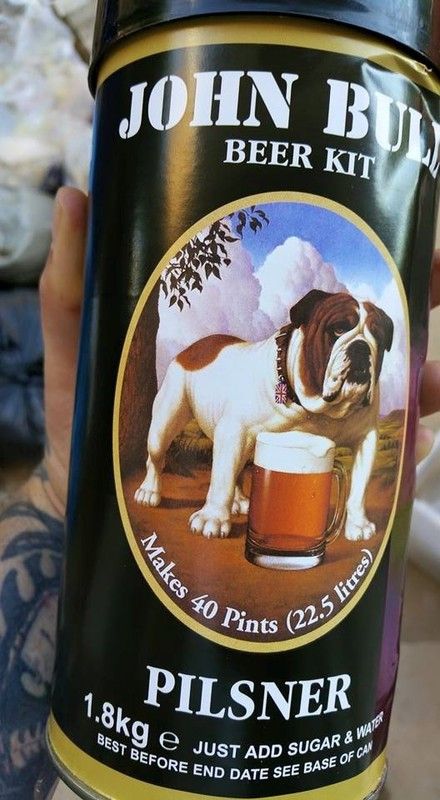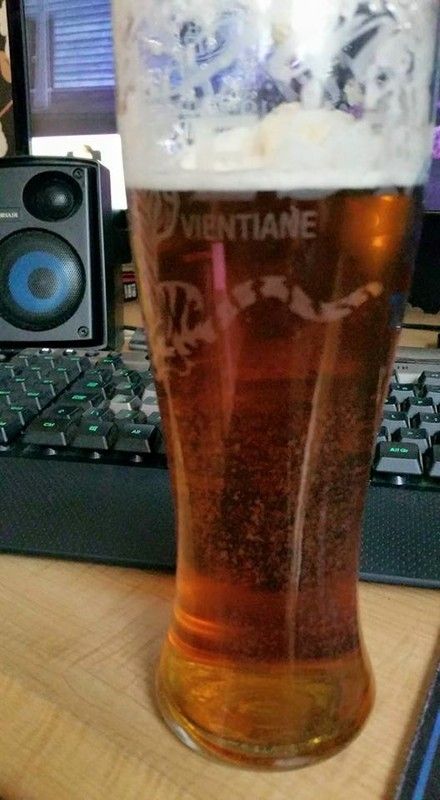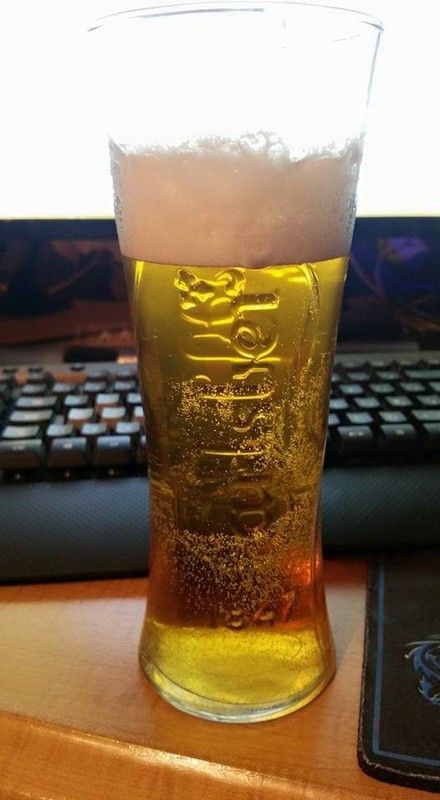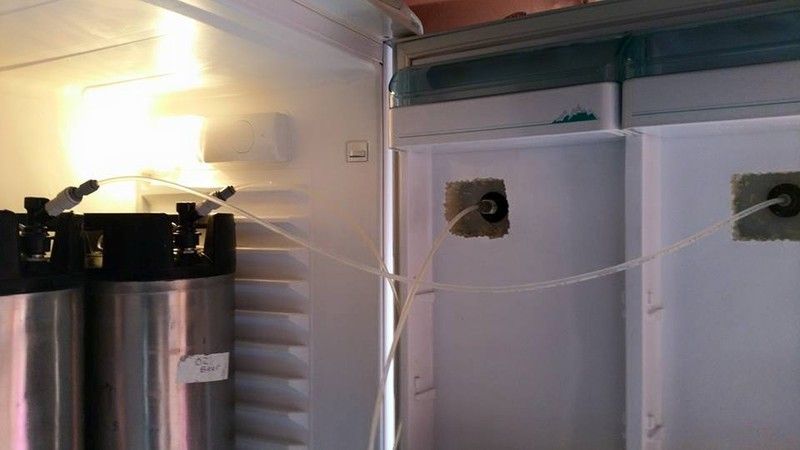You are using an out of date browser. It may not display this or other websites correctly.
You should upgrade or use an alternative browser.
You should upgrade or use an alternative browser.
Home brewing kits ....
- Thread starter Aliboy
- Start date
More options
Thread starter's postsPermabanned
- Joined
- 8 Feb 2004
- Posts
- 4,539
OK shaking your starter every time you go past it will increase your yeast count, and good luck if the weather is warm it may help keep the temp up as these beers are best fermented warmer than ales (but start low if you can)
Have a laboratory style magnetic stirrer plate so will use that to try and keep the starter well oxygenated. I read that the main problems with this strain of yeast is a stalled fermentation if it experiences a drop in temperature, hopefully it being left in-doors (airing cupboard) should prevent this. As you mentioned if you start with a high fermentation then it can lead to overpowering ester flavours and the potential for a stall.
Soldato
- Joined
- 17 Jan 2006
- Posts
- 4,288
Having checked again and with it still at a gravity of 1.010 I went ahead and bottled my brew last night.
Very thankful for all the tips I've picked up form here, making a syrup, getting a bottling valve thingy, using a second bottling vessel etc. it all proved very useful and made the job fairly simple, time-consuming but simple.
Just got to wait now and hope that the priming has worked well (went with batch priming, syrup in the vessel before I transferred the beer from the FV) and that I get a decent fizz and not exploding bottles...
Very thankful for all the tips I've picked up form here, making a syrup, getting a bottling valve thingy, using a second bottling vessel etc. it all proved very useful and made the job fairly simple, time-consuming but simple.
Just got to wait now and hope that the priming has worked well (went with batch priming, syrup in the vessel before I transferred the beer from the FV) and that I get a decent fizz and not exploding bottles...
Associate
- Joined
- 12 Jan 2009
- Posts
- 2,331
- Location
- Staffs
Are you using glass or plastic bottles? If it's plastic you should be able to feel how pressure builds up over time in the bottle, and with plastic bottle caps can vent gas if it's too high. Roughly how much sugar did you use for priming? We've tend to use between 60g to 110g of brewing sugar depending on how carbonated the style of beer should be. That's for a 5g brew.
Soldato
- Joined
- 17 Jan 2006
- Posts
- 4,288
I'm using plastic bottles as I got them for a bargain price, good to know about the venting, hadn't thought of that.
I used an online calculator to work out the sugar and added 160g (of brewing sugar), also a 5gallon brew. It's an american style lager so is intended to be quite fizzy.
I used an online calculator to work out the sugar and added 160g (of brewing sugar), also a 5gallon brew. It's an american style lager so is intended to be quite fizzy.
You will be wanting to use 3/16" beer line unless you want pints of foam.
Fair enough I make mostly foreign type beers, German style Lager, Wheat Beer, AIPA etc and had to resort to smaller dia lines to cope with the high carbonation levels.
cool m8
wheat beer is a nice drop and pale ale is nice

Permabanned
- Joined
- 8 Feb 2004
- Posts
- 4,539
Brew day report (extract quadrupel recipe posted earlier)
Got back much later on Friday evening that I planned due to traffic so didn't get going on the starter until 8:30 PM or so... Second thing that went wrong was that I had the incorrect kettle lead for my magnetic stirrer plate, bummer. Needless to say I pressed on by making up a 3 litre starter with 350g of the dry malt extract. Boiled for around 20 minutes or so and then cooled it in a water bath followed by a stint in the freezer. Pitched the yeast when the temp was around 20 degrees C or so and aerated it as best I could with a spoon. I covered it well with foil and left it over night.
Next day, the starter showed no signs of activity so I kept aerating it every hour or so. Around 3PM it showed good activity and around 6PM, when I started the main brew, it was very active and would violently froth up with agitation. I sanitised my equipment with some dilute bleach solution followed by copious amounts of tap water and then a final clean with star-san. On to the brew proper I realised my brew pot wasnt going to hold much more than 16 litres (allowing for decent headroom) which isn't great when trying to brew 30 litres of high gravity wort; I pressed on. It was my first time using steeping grain and until you have worked with grain you don't quite appreciate how much liquid it can absorb. After 30 mins of steeping I sparged with warm water until most of the sugars etc had come out and then added my LME to the brew pot. Unfortunately, I couldn't rinse the extra LME out of the pots with some water due to having insufficient head room in the brew pot... Furthermore, there wasnt enough room for the rest of the DME or sugar. I decided to bring it to boil and slowly add the additional sugars, and rinse fluid as liquid boiled off, however, I was wary the wort gravity would be mega high (which it was). Over about an hour I managed to add all the sugars to the pot and got it boiling with enough headroom to spare for a hop addition. Had a few boil-overs but nothing disastrous (I had started the brew with a glass of wine so was well on my way by this point). Was supposed to do the hop addition (75g) at 60 minutes (flame out) but couldn't be bothered to sanitise the bag so decided I could just add extra hops but do it earlier so the boil would provide the sanitation. Took a stab at going to 100g of hops (whole pack) at 50 minutes which it turns out was excessive. I will be on the upper limit of bitterness for this type of beer. Once I had finished the boil I was able to get the wort down to around 25 degress C in 30 minutes with the use of a water bath. I diluted the wort down in the fermentor with tap-water that had been treated with a small amount of a Campden tablet the day before and left to stand.
At this point, I realised my fermentor was actually too small to handle the full 30 litres and the most I could get in with leaving a reasonable head-space was around 26 litres... In hindsight if I had realised this previously I would have excluded the 1kg of table sugar from the boil... Despite this, I pitched the yeast (temp was around 21 deg C) and decided to leave my fate to the beer gods. My plan was/is to wait until the violent stage of fermentation had completed and then 'top-up' the fermentor with bottled water to bring the gravity close to where I want it to be (can probably get around 29.5 litres in). I spent a good 10 mins aerating the wort and headed to bed.
Yeast was pictched at around 11pm on Saturday and it took until this morning before the airlock started to bubble (some stirring in between). Apparently fermentation is now going well although it hasn't violently taken off like it has with some of the other brews have done (never made a starter before). Whether this is a good thing or not I have no idea but until then I'm just going to leave it for around 5 weeks before bottling... I will probably call the old man and ask him to top the fermentor up with the bottled water after around a week.
Got back much later on Friday evening that I planned due to traffic so didn't get going on the starter until 8:30 PM or so... Second thing that went wrong was that I had the incorrect kettle lead for my magnetic stirrer plate, bummer. Needless to say I pressed on by making up a 3 litre starter with 350g of the dry malt extract. Boiled for around 20 minutes or so and then cooled it in a water bath followed by a stint in the freezer. Pitched the yeast when the temp was around 20 degrees C or so and aerated it as best I could with a spoon. I covered it well with foil and left it over night.
Next day, the starter showed no signs of activity so I kept aerating it every hour or so. Around 3PM it showed good activity and around 6PM, when I started the main brew, it was very active and would violently froth up with agitation. I sanitised my equipment with some dilute bleach solution followed by copious amounts of tap water and then a final clean with star-san. On to the brew proper I realised my brew pot wasnt going to hold much more than 16 litres (allowing for decent headroom) which isn't great when trying to brew 30 litres of high gravity wort; I pressed on. It was my first time using steeping grain and until you have worked with grain you don't quite appreciate how much liquid it can absorb. After 30 mins of steeping I sparged with warm water until most of the sugars etc had come out and then added my LME to the brew pot. Unfortunately, I couldn't rinse the extra LME out of the pots with some water due to having insufficient head room in the brew pot... Furthermore, there wasnt enough room for the rest of the DME or sugar. I decided to bring it to boil and slowly add the additional sugars, and rinse fluid as liquid boiled off, however, I was wary the wort gravity would be mega high (which it was). Over about an hour I managed to add all the sugars to the pot and got it boiling with enough headroom to spare for a hop addition. Had a few boil-overs but nothing disastrous (I had started the brew with a glass of wine so was well on my way by this point). Was supposed to do the hop addition (75g) at 60 minutes (flame out) but couldn't be bothered to sanitise the bag so decided I could just add extra hops but do it earlier so the boil would provide the sanitation. Took a stab at going to 100g of hops (whole pack) at 50 minutes which it turns out was excessive. I will be on the upper limit of bitterness for this type of beer. Once I had finished the boil I was able to get the wort down to around 25 degress C in 30 minutes with the use of a water bath. I diluted the wort down in the fermentor with tap-water that had been treated with a small amount of a Campden tablet the day before and left to stand.
At this point, I realised my fermentor was actually too small to handle the full 30 litres and the most I could get in with leaving a reasonable head-space was around 26 litres... In hindsight if I had realised this previously I would have excluded the 1kg of table sugar from the boil... Despite this, I pitched the yeast (temp was around 21 deg C) and decided to leave my fate to the beer gods. My plan was/is to wait until the violent stage of fermentation had completed and then 'top-up' the fermentor with bottled water to bring the gravity close to where I want it to be (can probably get around 29.5 litres in). I spent a good 10 mins aerating the wort and headed to bed.
Yeast was pictched at around 11pm on Saturday and it took until this morning before the airlock started to bubble (some stirring in between). Apparently fermentation is now going well although it hasn't violently taken off like it has with some of the other brews have done (never made a starter before). Whether this is a good thing or not I have no idea but until then I'm just going to leave it for around 5 weeks before bottling... I will probably call the old man and ask him to top the fermentor up with the bottled water after around a week.
Nice story rubberduck  hope it all comes out great.
hope it all comes out great.
Also nice fridge Garfo looking ace.
On my side of homebrew, just put a Belgium Pale Ale kit in the fermenting bin, took ages to cool down enough though but its in and we shell wait and see what that comes out like.
My second bottled beer is come out rather tasty now which is awesome, all boxed most of it to let it sit for some months
 hope it all comes out great.
hope it all comes out great.Also nice fridge Garfo looking ace.
On my side of homebrew, just put a Belgium Pale Ale kit in the fermenting bin, took ages to cool down enough though but its in and we shell wait and see what that comes out like.
My second bottled beer is come out rather tasty now which is awesome, all boxed most of it to let it sit for some months

new stickers new lines
3/16" by any chance?
3/16" by any chance?
yes m8
 just easy now that its just push fit pipes [j guest]
just easy now that its just push fit pipes [j guest] 
Soldato
- Joined
- 17 Jan 2006
- Posts
- 4,288
My first batch, the gluten-free lager, has been in bottles for nearly 2 weeks now,not seen any visible signs of the secodnd fermentation occuring but the bottles feel quite firm to the touch (I foolishly didn't think to feel how they felt just after I'd filled them) so I'm hoping they're doing their thing and it'll turn out at least halfway drinkable.
After bottling up my first batch I decided to tru making a second kit, which is not gluten-free but came with the whole home brew kit I was given some years back.
I took onboard some of the tips I've read here, in particular the one about hydrating the yeast for a while before adding it to the FV, and within a day has a bucket of heavily fermenting real ale, my airloc was going mad and it was very frothy at the top of the FV. This never happened with the first kit,though to be fair, instructions did say it would not be vigorour as a non-gluten-free kit.
Also probably helped that the last week has been much warmer.
ANyway, after a few days the bubbling stopped and the gravity was at the level the instructions said it would get to. I left it another day, the gravity was the same so I transferred the whole lot into my 5g barrel where it is now sitting having been primed with a syrup. Again, hopefully it'll turn out ok.
After bottling up my first batch I decided to tru making a second kit, which is not gluten-free but came with the whole home brew kit I was given some years back.
I took onboard some of the tips I've read here, in particular the one about hydrating the yeast for a while before adding it to the FV, and within a day has a bucket of heavily fermenting real ale, my airloc was going mad and it was very frothy at the top of the FV. This never happened with the first kit,though to be fair, instructions did say it would not be vigorour as a non-gluten-free kit.
Also probably helped that the last week has been much warmer.
ANyway, after a few days the bubbling stopped and the gravity was at the level the instructions said it would get to. I left it another day, the gravity was the same so I transferred the whole lot into my 5g barrel where it is now sitting having been primed with a syrup. Again, hopefully it'll turn out ok.
Associate
- Joined
- 12 Jan 2009
- Posts
- 2,331
- Location
- Staffs
Sounds brilliant. Fingers crossed for them both for you. Did you sample the gluten free beer when you bottled it, and if so, how was it?



